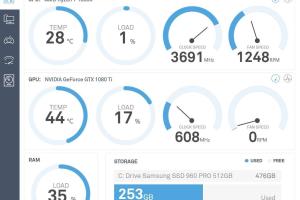4 Simple Methods to Keep Your CPU Temperature in Check

-
Quick Links:
- Introduction
- Why Monitor CPU Temperature?
- Method 1: Use Built-in BIOS/UEFI Tools
- Method 2: Utilize Software Monitoring Tools
- Method 3: Leverage Operating System Features
- Method 4: External Hardware Monitors
- Case Studies and Examples
- Expert Insights
- Conclusion
- FAQs
Introduction
The CPU (Central Processing Unit) is often referred to as the brain of your computer, making its performance critical for ensuring that your system runs smoothly. However, just like any other electronic device, CPUs generate heat, and excessive temperatures can lead to system instability, crashes, and even permanent damage. Therefore, monitoring your CPU temperature is vital for maintaining optimal performance and longevity. In this article, we will explore four easy ways to keep an eye on your CPU temperature.
Why Monitor CPU Temperature?
Monitoring CPU temperature is essential for several reasons:
- Prevent Overheating: High temperatures can lead to thermal throttling, where the CPU slows down to prevent damage, affecting performance.
- Enhance Longevity: Maintaining an optimal temperature can prolong the life of your CPU and other components.
- Improve Performance: Cooler CPUs can perform better, providing a smoother experience for users.
- Detect Issues Early: Monitoring can help you identify potential problems before they escalate into serious issues.
Method 1: Use Built-in BIOS/UEFI Tools
Most motherboards come equipped with BIOS or UEFI firmware that allows you to monitor your CPU temperature without needing additional software. Here’s how to access it:
- Restart your computer and enter the BIOS/UEFI setup. This is usually done by pressing a specific key during boot (like F2, Del, or Esc).
- Navigate to the hardware monitoring section. This section may be labeled as "Hardware Monitor," "PC Health Status," or similar.
- Look for CPU temperature readings. These values will often be displayed in Celsius or Fahrenheit.
While this method allows you to check temperatures, it does not provide historical data or alerts, making it less effective for long-term monitoring.
Method 2: Utilize Software Monitoring Tools
Several software applications can help you monitor your CPU temperature effectively. Here are some popular options:
- HWMonitor: A free tool that provides real-time monitoring of system temperatures, voltages, and fan speeds.
- Core Temp: A lightweight utility that specifically focuses on CPU temperature and provides detailed information about each core.
- MSI Afterburner: Primarily a graphics card overclocking tool, it also allows you to monitor CPU temperatures alongside GPU metrics.
- Open Hardware Monitor: An open-source application that monitors temperature sensors, fan speeds, voltages, load, and clock speeds of a computer.
To use any of these tools, simply download and install your preferred software, then follow the on-screen instructions to view your CPU temperature readings.
Method 3: Leverage Operating System Features
Both Windows and macOS have built-in features to help monitor your system’s health. While they may not give you specific temperature readings, they can provide valuable insights into your CPU’s performance:
For Windows:
- Open Task Manager by right-clicking on the taskbar and selecting “Task Manager.”
- Click on the “Performance” tab to view CPU usage and performance metrics.
- Use the “Resource Monitor” for more detailed information on processes and their impact on CPU performance.
For macOS:
- Open the “Activity Monitor” from the Utilities folder.
- Click on the “CPU” tab to see real-time CPU usage and resource allocation.
While these methods do not provide temperature readings, they can help identify high CPU usage scenarios that may indicate overheating.
Method 4: External Hardware Monitors
If you prefer to monitor your CPU temperature with dedicated hardware, there are external solutions available. Here’s how you can set them up:
- USB Temperature Sensors: These sensors can be plugged into a USB port and provide real-time temperature readings through accompanying software.
- Digital Thermometers: You can place a digital thermometer near your CPU for a general idea of temperature, though it won't be as accurate as software monitoring.
External hardware solutions can be beneficial in environments where software monitoring is not ideal, such as older systems or those that are not connected to the internet.
Case Studies and Examples
Let’s explore some real-world scenarios where monitoring CPU temperature made a significant difference:
Case Study 1: Gaming PC Optimization
A gaming enthusiast noticed frequent crashes during intensive gaming sessions. Upon monitoring CPU temperatures using HWMonitor, they discovered that their CPU was overheating due to inadequate cooling. After upgrading the cooling system and optimizing airflow in the case, they experienced a stable gaming performance.
Case Study 2: Workstation Performance
A graphic designer working with large files faced slow performance. By regularly monitoring CPU temperatures, they found that their CPU was consistently running hot due to dust buildup. After cleaning the fans and applying new thermal paste, CPU temperatures dropped, and performance improved significantly.
Expert Insights
To gain further understanding, we consulted a hardware specialist, Dr. Jane Smith, who shared her insights on CPU temperature management:
"Monitoring CPU temperature is critical not only for performance but also for system reliability. Many users underestimate the impact of heat on their systems. Regularly checking temperatures can prevent long-term damage and ensure your hardware remains in peak condition."